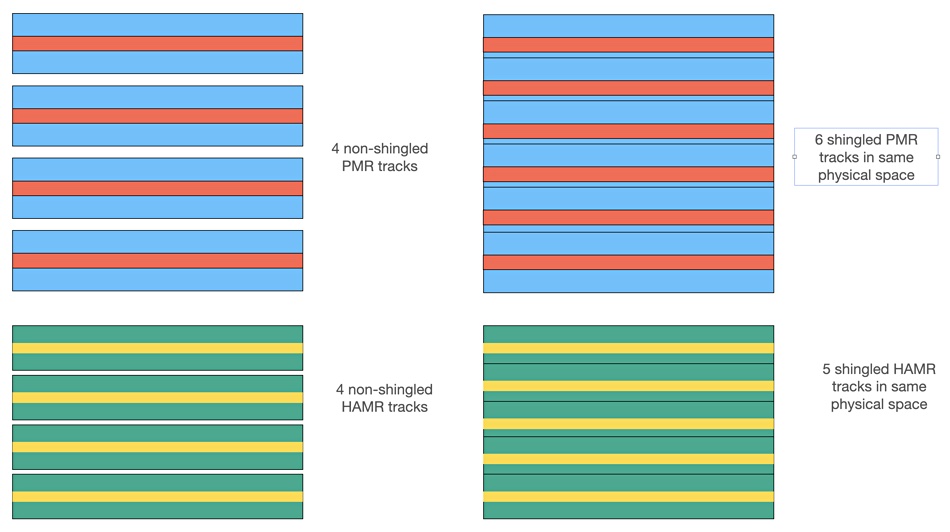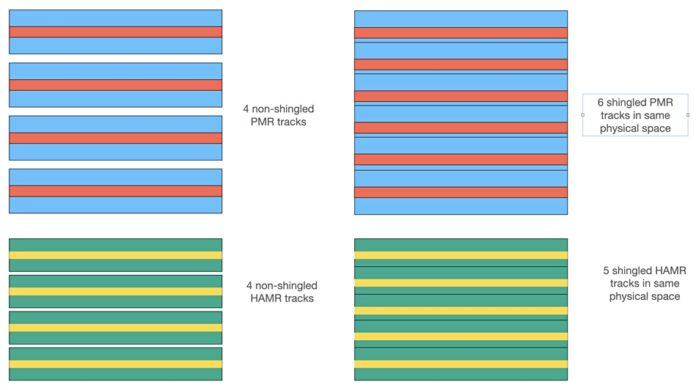Shingled HAMR disk drives get a lower capacity increase than existing conventional drives. Is this due to HAMR technology itself or higher capacity drive tracks being narrower with less scope for shingling?
SMR (shingled magnetic recording), with its overlapped write tracks, delivers a capacity increase over PMR (perpendicular magnetic recording), also known as conventional magnetic recording (CMR), because a read track is narrower than the write track. A read head, which senses bit area magnetic direction, is narrower than a write head, which writes bit area magnetic direction. If you partially overlap write tracks but preserve the read tracks, you can add 17 to 20 percent or more capacity to the disk drive. You basically get more free physical space on the drive and can add extra tracks to the disk platters.
A Dropbox document says: “When shingled, track width is no longer limited by the size of the write head, but the size of the read head, which can read a much narrower track. Shingling increases the capacity of SMR drives by about 20 percent over conventional perpendicular magnetic recording (PMR) drives.”
Bear in mind that the write and read tracks on an SMR drive are closer together than on a non-shingled drive so the overall gap between the read tracks is less. There still needs to be a gap between the read tracks to prevent cross-track interference.
The larger the difference between write track width and read track width, the bigger the capacity advantage delivered by shingling. The implication is that there is less scope for shingled capacity addition on HAMR or higher capacity drives because the write tracks are not that much wider than the read tracks.

A 24TB Seagate or Western Digital PMR drive becomes a 28 TB SMR drive, gaining 4 TB, meaning 16.66 percent more capacity.
But Seagate’s Exos 30 TB HAMR drive only becomes a 32TB drive in its SMR version – 2TB more. That’s only a 6.66 percent capacity increase. Why is this proportionally smaller than the PMR drive’s shingling increase?
HAMR drive tracks are closer together and narrower than PMR tracks, which means shingling can only increase capacity by around 7 percent instead of about 17 percent with PMR technology.
A conventional PMR drive, for example, may have a 2:1 ratio between write track width and read track width, meaning the read track is half the width of the write track. A HAMR or other higher capacity drive may only have a 1.3:1 ratio, with the write track a third wider than the read track. This provides much less scope for overlapping the write tracks while leaving the read tracks undisturbed. These are hypothetical numbers of course.
The Dropbox document discusses the company’s experience with HAMR drives, saying “HDD data tracks become smaller and spaced more closely together” with HAMR technology. It also talks about the need for better control of vibration. Narrower tracks could mean less tolerance for vibration. Putting limits on the width reduction of write and read tracks and the gap between them could be one result of this.
We asked Seagate for the reasons that its HAMR drive shingling adds a proportionally lower capacity increase than conventional drive shingling. Jason Zimmerman, Sr. Director of Product Line Management, told us: “The Mozaic 3+ product offerings are not necessarily completely indicative of the overall SMR vs CMR gains at a fundamental technology level. Generally, with Mozaic 3+, we are observing approximately ~10 percent additional capacity gains with SMR over CMR. So, I would not quote the 6 percent as completely indicative of the technology capability.
“The observation is generally correct that with higher TPI (narrower tracks) on any CMR will result in less SMR gains…however, this relationship is independent of recording technology (this is true whether it is HAMR or standard PMR). I would not “label” the higher track density in your figure as “HAMR Tracks”…as it will be true for any recording technology that increased “Conventional” CMR TPI. The label “HAMR lowers shingling capacity addition” does not seem fundamentally true.” It’s Zimmerman’s emboldening in this paragraph..








